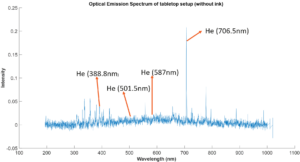Plasma modeling
Microplasmas have been studied for over 25 years due to their interesting properties and for applications in medicine (sterilization, wound healing, skin treatment, cancer treatment, teeth whitening, etc.), material synthesis (especially various nanoparticles, carbon nanomaterials), air purification, plasma displays, and many others. When operated at atmospheric pressure, the microplasmas are characterized by very high electron densities in small volumes in contrast to the popular low-temperature plasmas used in semiconductor processing. The high surface-to-volume ratio also results in high power densities in this non-equilibrium plasma. The classification of microplasmas is very wide based on frequency, power supply, geometry, and other parameters such as micro gap discharges, cathode boundary layer, micro hollow cathode discharges, DBD, microtubes, capacitively coupled or inductively coupled, or microwave micro-discharges, to name a few. My focus here is on micro DBD operated at atmospheric pressure and low frequency (few tens kHz range) with gas flow, as used in commercial plasma printers. Sometimes these are known as plasma jets or plasma pencils. Though available models and plasma diagnostics in the literature sampled above provide us some knowledge about the plasma jet in printing applications, a detailed understanding of the plasma jet carrying ink droplets is not available now but needed for advancing the technology. This work is supported by NASA
Optical Emission Spectroscopy
We use Optical emission spectroscopy to study the signatures of plasma in the novel plasma jet printer. We identify the electron temperature and density using the line ratio method.
